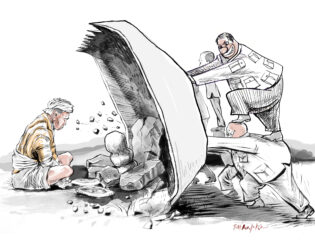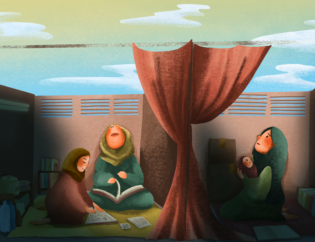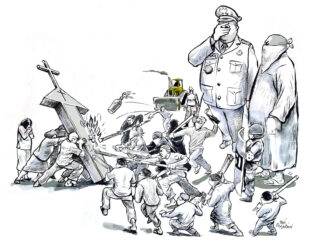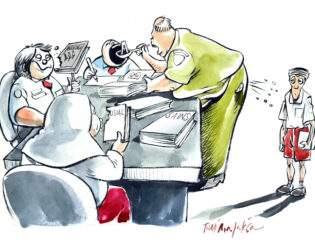U.S.intelligence reports linked the Indonesian military to the 2002 murder of American school teachers in Timika. Despite these reports, and opposition from theU.S.Congress, the Bush Administration moved to remove a decade-old ban on funding for military education programs (IMET) inIndonesia. In May 2006, the Bush Administration announced a new Pentagon program that will provide up to $19 million in additional funds for building Indonesian military capacity. An Indonesian court charged that Antonius Wamang, an alleged Papuan guerrilla, was the ringleader of this attack and sentenced him to life in prison on7 November 2006. Six other coconspirators were given sentences ranging from 18 months to seven years in jail. Yet, questions remain about whether Wamang’s group acted alone.
This report—prepared for the Joyo Indonesian News Service and the Pantau Foundation—is based on internal police documents, court records, eyewitness accounts, and exclusive interviews with Wamang. The key points of evidence presented in the murder trial are equivocal. The Indonesian government has partnered with the Bush Administration to prosecute some of the alleged murderers at mile 63. Yet, the rigorous standards of evidence that would have been applied in aUScourt room have not been upheld.
“Murder at Mile 63” is being released in a three part series. Part One, “A Trip to theBigCity”, was released on7 November 2006and posed two key questions: Where did Wamang obtain bullets? Did Indonesian military agents have prior knowledge of the attack? Part Two, “The Ambush”, asks: Was another group of shooters present at the ambush site? Why were Indonesian troops slow to respond? Part Three, “The Cover-Up”, addresses a final pair of questions: Did the FBI earnestly pursue evidence of Indonesian military involvement? Why did the Indonesian military sue reporters, doctor the crime scene, intimidate witnesses, and conduct a sham reconstruction?
The Cover Up
The day after the murders at mile 63, the Free Papua Movement (OPM) spokesman John Otto Onawame issued a statement alleging that the attack was "orchestrated by the Indonesian military."[1] Indonesia’s Foreign Ministry spokesman Marty Natalegawa made the opposite charge: "There are indications the act was committed by elements of OPM."[2] International media outlets immediately splashed news of the murder, and the competing allegations, across their pages. In the midst of these accusations Elsham Papua, an internationally-recognized human rights group, sent a team of investigators to Timika.
On 8 September 2002, a crowd of Amungme villagers approached a vehicle driven by Elsham investigators as it pulled into Utikini village. The team was investigating the identity of “Mr. X”, or Elias Kwalik, an Utikini native. Paula Makabory, a team member, told us, “Some villagers carried axes, others hefted large stones. A rock hit the SUV and then another.” The driver jammed the vehicle and sped backwards down the road.
Elias Kwalik’s relatives later told the Elsham team that three Indonesian agents had been in Banti earlier that day.[3] The agents provoked the villagers into attacking the human rights investigators, Makabory said. Intelligence agents stationed at the local Mimika military command also routinely followed Makabory, and other Elsham team members.[4]
Elsham issued a preliminary report on 26 September, saying that evidence “suggesting the shooting was carried out by Indonesian military personnel (TNI) or groups facilitated by the TNI.”[5] BBC, Radio Australia, and many Indonesian newspapers covered the report. Two days later, the Indonesian military announced that it was to sue Elsham. A court summons arrived in November, announcing that John Rumbiak and Elsham director Yohanis Bonai were being sued for libelous statements.[6]
On 10 October, thugs raided Elsham Papua’s Jakarta office.[7] “During the raid, the men seized documents and computer diskettes containing Elsham reports on the August ambush”, wrote the Jakarta Post[8]
Yohanis Bonai’s wife, Elsje, and other members of their extended family, were attacked by unknown gunmen while travelling by car near the border between Indonesia and Papua New Guinea on 28 December 2002. Elsje Bonay was shot in both of her legs.[9] She survived the attack, but after repeated surgeries she still has difficulty walking. Tempo magazine ran a story with the headline: “Shooting of Papuan Human Rights Activist’s Family May Be Related to Timika Incident”.[10]
Brigadier General Raziman Tarigan headed the Indonesian police investigation and worked closely with Elsham investigators.[11] The extensive ballistic and forensic research conducted by the Indonesian police pointed to military perpetrators. Tarigan told reporters that the 13 guns used in the attack—six SS1s, five M16s, and two Mausers—were the types of weapons issued to soldiers stationed in the area.[12] “Only the military and Freeport workers pass through the area”, Tarigan was quoted as saying by Koran Tempo[13]
Separately, Major General I Made Mangku Pastika, Tarigan’s immediate superior, told three senior military officials: “Gentlemen, this country belongs to all of us. If you do something for the sake of the country and the nation, well, please tell us first. So we’re not all in trouble.”[14] Saul Tahapary, a Freeport security consultant, was party to this conversation during a meeting at the Timika police headquarters. He said that Pastika was upset with attempts by the military to cover up their own actions.
Tarigan and Pastika were transferred off of the investigation to new assignments elsewhere in Indonesia. Pastika was assigned to investigate the Bali bombing that killed more than 200 people.
An Indonesian military reconstruction was conducted by a team from Indonesia’s Central Military Police (Puspom TNI). Their stated mission was to clarify a reports by Tarigan and Pastika. According to Richard Saferstien’s authoritative text on criminology, a murder reconstruction involves answering a series of questions: (1) was there more than one person involved? (2) how was the victim killed? (3) were there actions taken to cover up what actually took place?[15] The Indonesian military reconstruction did not rigorously attempt to answer any of these three questions. In fact, this “reconstruction” itself is further evidence of a cover up.
Decky Murib claims that he was threatened and intimidated by Indonesian soldiers on 28 December 2002, the day of the reconstruction.[16] In the months prior to this day Murib had worked with Indonesian police investigators to identify Kopassus soldiers whom he alleged were at the crime scene: Captain Margus Arifin, First Lieutenant Wawan Suwandi, Second Class Sergeant I Wayan Suradnya, and First Class Private Jufri Uswanas.[17] Murib told us that he had changed his story as a result of threats by Captain Margus on the day of the reconstruction.[18] In response to these threats, Murib remembers saying, “If you want to shoot me, go right ahead.”[19] Captain Margus told Murib to not participate in the reconstruction. As a result Murib decided to go into hiding.[20]
Rather than conducting a comprehensive reconstruction of the crime, the Indonesian military focused on discrediting Decky Murib’s testimony.[21] Murib initially told investigators that he heard gun shots from his position in between mile 61 and 62 of the Timika-Tembagapura road at the time of the attack.[22] At this spot there was a large pole, shipping containers, and a place to sit.[23] On 28 December 2002 at 11:30 AM, the Indonesian military reconstruction team traveled by bus to mile 58. Deminikus Bebari of the Amungme Indigenous Council (Lemassa) and Albert Bolang of the Legal Aid Institute were accompanying the team as outside observers. Bebari protested, saying that mile 58 was not the right place. The team then traveled approximately 500 meters up the road and positioned themselves under some umbrellas by the roadside. The pole and shipping containers, from Murib’s testimony, were nowhere in sight. Over four miles of road and a tunnel separated Bebari from the site where Murib claimed to have heard the shots.[24]
Albert Bolang traveled with a Brimob mobile police unit further up the road to the site of the shooting at mile 63, while Bebari stayed with the rest of the reconstruction team at mile 58. Once both teams were in place, 20 bullets were shot in an automatic burst. Radio contact was made between the two groups. The reconstruction team, and independent observer Bebari, did not hear the gun shots. Brigadier General Hendarji, who headed the military reconstruction team, confronted Bebari as they stood on the road immediately after the shooting experiment. Hendarji said that since they did not hear any gun shots then all of Murib’s testimony about the Timika shooting were lies.[25]
That evening Bolang and Bebari were asked to sign two reports: Bolang signed a document that described the shooting experiment at mile 63 while Bebari signed a document stating that he did not hear gun shots at mile 58. In addition, Bebari was asked to sign an additional statement: “The testimony of Mr. Decky Murib is false and will not be used in the investigation of this case.”[26] Deminikus Bebari refused to sign this document. “Decky might be a drunkard and an opportunist but he was at mile 62. How could we test whether he had heard the shots or not when I was placed four miles away from his position? They simply wanted me to state that he lied?” said Bebari.[27]
In January 2003, Decky Murib was flown to Jakarta by Indonesian military officials.[28] Major General Sjafrie Sjamsoeddin, the Indonesian military spokesman announced on 14 January 2003, “Decky Murib lied.”[29] Sjamsoeddin himself was recently a target of criticism for not stopping anti-Chinese riots in Jakarta in May 1998.
The reconstruction took place at the height of President Megawati Sukarnoputri’s effort to restore military ties with the United States. Her chief security minister, Susilo Bambang Yudhoyono, told reporters, “There are some things that do not match between the investigation results of the police and the results of the TNI (military) internal investigation into the case.” Yudhoyono also called for a “synchronization” of the two investigations at “the political level.”[30] Yudhoyono is now Indonesia’s president.
Recovering from her gunshot wounds, and mourning her lost husband, Patsy Spier closely followed the news as police investigators implicated Indonesian military troops in the attack. When the Indonesian military took over the investigation, and promptly exonerated themselves, Patsy began her campaign for justice. After making a few tear-choked phone calls to the offices of Washington policy makers, she learned that the US government was poised to fund a controversial program for Indonesian soldiers under the International Military Education and Training (IMET) program. “I just, I just couldn’t believe it,” Patsy told ABC reporters, “If the Indonesian police had implicated the Indonesian military, why would my government want to give money to that military?”[31]
The Bush Administration made military aid to the predominantly-Muslim Indonesia a high priority in the post-September 11th era. Following the well-publicized Santa Cruz massacre in East Timor, the U.S. Congress blocked military aid to Indonesia in 1992. All military assistance to Indonesia had been cut by the Clinton Administration in response to the bloodbath during the 1999 independence referendum in East Timor.[32] When Spier first came to Capitol Hill in early 2003, human rights groups—Amnesty International, Human Rights Watch, and the East Timor Action Network—were losing a battle to keep restrictions on Indonesian military financing.
Patsy’s presentations to lawmakers were well received: she stuck to the facts, she packed an emotional punch, and she relentlessly pursued her objective of justice. She secured meetings with some of the top U.S. government officials: then Deputy Secretary of Defense Paul Wolfowitz, FBI director Robert Mueller, key Senators, and Congressmen.[33]
Immediately following the Timika ambush, Federal Bureau of Investigation (FBI) agents interviewed Patsy and victims who had been evacuated to Australia for medical treatment. The FBI figures prominently in the American collective imagination as a specter of government persecution. The bureau famously placed John Lennon under surveillance. Following the Patriot Act, FBI bureaucrats have been given expansive new powers to examine the lives of ordinary Americans.[34] Despite the checkered history of this institution, Patsy Spier came to see FBI Special Agents Paul Myers, Brad Dierdorf, and Ron Eowan as her personal “guardian angels”.[35] As she came to be assaulted by incomplete and conflicting reports from police investigators, military officials, and independence activists, Patsy looked to the FBI to provide her with no-nonsense distinctions between truth and fabrication.
Initially FBI agents were only permitted short visits to Timika. All their interviews of witnesses were, at first, conducted in the presence of Indonesian minders.[36] “We were objective,” said Brad Dierdorf during the interrogation of a witness on 24 February 2005, “Our gut feeling initially leaned away from Papuans.” The Australian published a sensational headline on 28 October 2002, “FBI: Army Lied about Papua Ambush.”[37] This story discussed the planting of false evidence and removal of other evidence from the scene of the killing. Despite repeated high-level requests from the U.S. government, including a personal appeal by President Bush, the FBI had continual difficulties in gaining access to witnesses and material evidence.[38]
Initially Spier saw that restricting funds for the Indonesian military would provide a financial incentive for cooperation. Following a closed door session of the Senate Foreign Relations Committee on May 20, 2003—where a CIA analyst presented an intelligence brief on the case—Sen. Russell D. Feingold (D-Wis.) sponsored an amendment to prohibit “normalization” of the US-Indonesia military relationship. Sen. Wayne Allard (R-CO) sponsored a parallel amendment that prohibited the release of $600,000 in IMET military training funds. Both amendments passed in October 2003. Only “full cooperation” with the FBI in its investigation into the Timika ambush would prompt Washington to release these funds to the Indonesian military. The Indonesian military eventually bowed down to these pressures.
These congressional measures stymied Bush Administration efforts to restore full military ties with Indonesia. Ed McWilliams, formerly the Political Secretary of the U.S. Embassy in Jakarta, told us, “The FBI investigation, once it was finally launched, proceeded in the constraining political context of an Administration policy which concurrently was pressing for rapid expansion of U.S.-Indonesian military ties. I personally observed FBI reluctance to accept or pursue information offered to it that pointed to Indonesian military involvement in the killings”[39] Over a two-year period Elsham supervisor John Rumbiak presented the FBI with specific verifiable details about Wamang’s ties to the Indonesian military.[40] Senator Joseph R. Biden submitted written questions about this case to Dr. Condoleezza Rice during her January 19, 2005, confirmation hearing for the position of U.S. Secretary of State. In response, Dr. Rice stated, “Although the investigation is not complete, the FBI has uncovered no evidence indicating TNI (military) involvement in the Timika murders.” Did FBI investigators brief administration officials about Wamang’s trip to Jakarta and his extensive contacts with military agents? Were U.S. leaders informed about eyewitness reports of a second group of shooters?
Following nearly a year of inactivity, Elsham was again summoned to court in Jayapura on 11 February 2004 in connection with the defamation lawsuit from the TNI. Elsham investigators closely collaborated with the FBI in the early stages of the bureau’s investigation into the Timika attack. In addition to providing the FBI with specific evidence of TNI involvement in the attack, Elsham gave the agents crucial information that eventually led to the indictment of Antonius Wamang.[41] Yet, the US government sent no observers to this trial.
Decky Murib was brought as a prosecution witness in the defamation suit against Elsham on 31 March 2004. During the course of the trial Murib stayed in the personal guest quarters of the Indonesian military commander for Papua or the Trikora military command. On 14 April 2004, the Elsham legal defense team staged a walk-out because the judge would not give them the opportunity to cross-examine Murib. The Elsham defense team was finally given the opportunity to question Murib on 5 May 2004, but Murib refused to answer any questions. On three separate occasions Murib made death threats to Bebari, the human rights worker who participated in the military reconstruction, in front of the court. The Elsham defense team asked that the judge take note of the threats. If bodily harm should come to their witness, the Elsham defense team noted that Murib would be suspected as the perpetrator.
Approximately one month later Bebari’s house was ransacked by an angry mob. A group of men wielding axes entered the house and grabbed Nirmala Ohee, Bebari’s wife, and their three children. The men destroyed books, clothes, and other personal property. They threatened to kill Nirmala Ohee and her three children with an axe.[42] Since this incident Bebari has received a number of threatening phone calls and has been routinely followed by the police.[43]
Then US Attorney General John Ashcroft and FBI Director Robert Mueller announced on 24 June 2004 that Antonius Wamang had been indicted for the murders at mile 63. The indictment alleged that Wamang was a fighter for an independent Papua with the OPM/TPN (Organisasi Papua Merdeka/Tentara Pembebasan Nasional). Ashcroft omitted any reference to evidence that the Indonesian military (TNI) was involved in the August 2002 attack. The U.S. Department of Justice has not exonerated the TNI, but the TNI subsequently claimed exoneration. Following Wamang’s indictment the Bush Administration moved to eliminate a decade-old ban on funding for military education programs (IMET) in Indonesia.
Less than one week after Wamang’s indictment, Jayapura District Court in Papua found Elsham guilty of libel. The rights group was fined 50 million Rupiah (US$5,263) on 30 June and ordered to publicly apologize through national print and television media.[44]
Following the indictment of Wamang, Congress dropped provisions that tied military education programs in Indonesia to cooperation in the Timika investigation. Yet, Indonesian authorities failed to mount a sustained effort to capture him. Willy Mandowen, a Papuan politician, began talking with the FBI and U.S. government officials about negotiating Wamang’s surrender. He sent an e-mail to a public discussion forum for Papuan activists on 7 December 2005: “Tomorrow at Capitol Hill, Washington D.C., we are meeting with important representatives of the U.S. Congress who are giving full support to help us resolve our problems in West Papua.”[45] Congressional staffers talked with Mandowen, and other Papuan leaders, about the possibility that FBI agents might bring Wamang to stand trial in America.[46]
With Willy Mandowen’s help, Paul Myers and Ron Eowan—two of the FBI agents on this case—coordinated a 11 January 2006 “meeting” at a small hotel in Timika called Amole Dua.[47] Invitations to this meeting were sent to suspects in the 2002 killings. A local church leader, Reverend Isak Onawame, delivered the invitations. The Washington Post reported that the FBI pledged that the detainees would be transferred to the U.S. for trial.[48] The two FBI agents told the 11 men, and Reverend Onawame, to get into the back of a medium-sized truck. The agents reportedly said it was the first stage of their journey to America. Instead of driving to the airport, Myers and Eiowan dropped the men at a nearby police station where Indonesian troops with the elite Brimob unit were waiting.[49]
First the Indonesian police officers strip searched the 12 men. Some of the questioning began while detainees were just wearing their underwear. One of the detainees, a man named Jairus Kibak, claimed that he was hit by an Indonesian interrogator on his forehead. Kibak also claimed that he was kicked in his leg. The questioning began about 10:30 p.m. and continued well into the next day.[50]
Antonius Wamang has repeatedly said that Reverend Isak Onawame and his two church assistants, Jairus Kaibak and Esau Onawame, were not involved in any crime. “It’s fine if I am held responsible,” Wamang said, “but, the Reverend didn’t help us with logistics.”[51] Denny Yomaki, Secretary of Elsham Papua, met with Reverend Onawame in prison on 12 January 2006 in the midst of intensive questioning by police and military agents. “Interrogators extracted a false confession from Reverend Onawame. He told the police that he gave Wamang food.” Four of the 12 men initially detained were soon released by Indonesian authorities.[52] Reverend Onawame and the two other church workers were not among those released.
When the prisoners were transferred to a jail facility in Jakarta they were not given their own beds, or even their own cells, to sleep in. Ishak Onamawe said that they would have had to pay Rp 15 million ($1,650) per cell. Instead they all shared the prison "TV room" along with two Chinese prisoners who have been charged with unrelated crimes. Hardi Tsugumol, who was charged with providing Wamang with logistical support, developed serious heart problems in June 2006. Initially his medical treatment was delayed until late August, when he underwent heart surgery. Tsugumol also suffered from hepatitis and HIV/AIDS. One of the prisoners’ lawyers, Riando Tambunan, repeatedly told the court to give attention to Tsugumol’s health problems. But, visits from doctors were infrequent.
On November 7th, 2006, Antonius Wamang was sentenced to life in prison by a Jakarta court. Two of the six other defendants were sentenced to seven years in jail, while the other four, including Reverend Isak Onawame and Hardi Tsugumol, were sentenced to 18 months.[53] Tsugumol died on December 1st
Sergeant Puji, the police officer who supplied Wamang with the bullets used in the attack, has not been charged with any crime. Evidence of the reported involvement of Kopassus military agents—Captain Margus Arifin, First Lieutenant Wawan Suwandi, Second Class Sergeant I Wayan Suradnya, and First Class Private Jufri Uswanas—has not been heard by a court of law. Agus Anggaibak, who initially inspired Wamang’s attack and helped him get bullets, remains at large. In late November Anggaibak brought a crowd of rowdy protestors to Freeport offices where they demanded that the mining giant supply his company, Elat Merah, with scrap metal.[54]
The FBI does not yet consider this murder investigation closed.[55]Despite the unanswered questions surrounding the deaths of two U.S. citizens in a remote Indonesian province, the Bush administration has begun an aggressive new program of military aid. Earlier this year a new Pentagon program was announced that will provide up to $19 million in additional funds for building Indonesian military capacity. The same day that Wamang was sentenced to life, Washington signaled a “new era of military co-operation” with Indonesia.[56]
[1] Mark Doris, “Statement by West Papua Action”, sent to westpapua@yahoogroups.com on 1 September 2002.
[2] “Army Hunts Indonesian Ambush Gang”, CNN.com/World, September 1, 2002 Posted: 12:56 AM EDT (0456 GMT).
[3] “Indonesian Rights Group Receives ‘Death Threats’ after Freeport Killings” BBC Worldwide Monitoring, 23 September 2002. “Tim Elsham dan Polisi Mendapat Ancaman Pembunuhan dan Terror”, Elsham Papua, Mimika, 18 September 2002.
[4] “Tim Elsham dan Polisi Mendapat Ancaman Pembunuhan dan Terror”, Elsham Papua, Mimika, 18 September 2002. Indonesian original reads: “‘Dimana rumah orang Amungme disekitar sini.’ Tetapi para tetangga itu menjawab disini tidak ada rumah orang Amungme.”
[5] Elsham Papua, “What Happened at Freeport”, September 26, 2002.
[6] Andi Imran to Yohanis Bonai, “Somasi”, 15 November 2002.
[7] Alberth Rumbekwan, “Kronologi Peristiwa Pembongkaran Kantor Perwakilan Elsham Papua di Jakarta”, sent to westpapua@topica.com on 16 October 2002.
[8] “Office of Rights Group Probing Papua Shootings Attacked”, TheJakartaPost, 28 October 2002.
[9] Nethy Dharma Somba, “Wife of Human Rights Activist Shot at Papua-PNG Border”, The Jakarta Post, 29 December 2002.
[10] “Shooting of Papuan Human Rights Activist’s Family May Be Related to Timika Incident”, Tempo Interactive, 28 December 2003 20:54:13 WIB.
[11] Soal Penembakan Di Timika Belum Ada Bukti Keterlibatan TNI, 09 Jan 2003, Available online: http://www.tni.mil.id/news.php?q=dtl&id=232
[12] Dudon Satiaputra, “Rahasia: Laporan Hasil Sementara Pemeriksaan TKP Penembakan Kary. PT. Freeport”, Jakarta, 19 December 2002. “Police say Indonesian Army Behind Papua Ambush”, Agence France Presse, 26 December 2002.
[13] Tom Hyland “Police Blame Army for Papua Ambush”, The Age, 27 December 2002; “Police say Indonesian Army Behind Papua Ambush”, Agence France Presse, 26 December 2002.
[14] Interview Saul Tahapary with AH 6 November 2006 in Jakarta. Original quote: Mas, negara ini khan punya kita semua. Kalau demi bangsa dan negara, ya kasih tahu dulu, supaya kita ini tidak repot semua.” According to Tahapary, Pastika made this statement to Maj. Gen. M. Yasin (deputi Menko Polkam bidang Politik Dalam Negeri), Brig. Gen. Mamat Rachmat and Drs. Yudho of Coordinating Minister on Security and Politics Susilo Bambang Yudhoyono’s office.
[15] Saferstien, Richard. Criminalistics: An Introduction to Forensic Science, 7th Edition. Prentice Hall (2001), p. 69.
[16] Decky Murib, tape-recorded interview with SEK on 26 March 2005. Indonesian original: “Bapa mau temabak saya, silahkan.”
[17] “Saran Tindak Lanjut BAP Saksi Sdr Decky Murib (TBO Kopassus)”, Timika, 28 September 2002.
[18] Decky Murib, tape-recorded interview with SEK on 26 March 2005.
[19] Decky Murib, tape-recorded interview with SEK on 26 March 2005. Indonesian original: “Bapa mau temabak saya, silahkan.”
[20] Decky Murib, tape-recorded interview with SEK on 26 March 2005.
[21] Deminikus Bebari, “Kronologi Pemeriksaan Saksi (Decky Murib) oleh Puspom TNI atas Aksi Penembakan Mill 63 Ruas Jalan Timika-Tembagapura”, 6 January 2003.
[22] “Berita Acara Pemeriksaan (BAP) Saksi Penembakan di Mile 63 Ruas Jalan Timika-Tembagapura 31 August 2002”, report on interview with Decky Murib by Lemassa, 7 September 2002.
[23] “Kesaksian Deky Murib di Polda Papua Tentang Penembakan di Mile 62-63 Tembagapura”, Polda, Jayapura, 18 September 2002.
[24] Deminikus Bebari, “Kronologi Pemeriksaan Saksi (Decky Murib) oleh Puspom TNI atas Aksi Penembakan Mill 63 Ruas Jalan Timika-Tembagapura”, 6 January 2003.
[25] Deminikus Bebari, “Kronologi Pemeriksaan Saksi (Decky Murib) oleh Puspom TNI atas Aksi Penembakan Mill 63 Ruas Jalan Timika-Tembagapura”, 6 January 2003.
[26] Deminikus Bebari, “Kronologi Pemeriksaan Saksi (Decky Murib) oleh Puspom TNI atas Aksi Penembakan Mill 63 Ruas Jalan Timika-Tembagapura”, 6 January 2003. Indonesian original: “Kesaksian Saudara Decky Murib tidak benar dan tidak akan digunakan sebagai bahan penyelidikan kasus ini”.
[27] Deminikus Bebari interview with AH, Jakarta, 13 November 2006.
[28] Deminikus Bebari interview with AH, Jakarta, 13 November 2006.
[29] KAPUSPEN TNI : KESAKSIAN DECKY MURIB BOHONG, 14 Jan 2003, Available on-line: http://www.tni.mil.id/news.php?q=dtl&id=239
[30] Tom Hyland “Police Blame Army for Papua Ambush”, The Age, 27 December 2002.
[31] Anthony Balmain, “Ambush in Papua”, Australian Broadcasting Corporation, 7 August 2004.
[32] Dana Priest, “Nightmare and a Mystery”, Sunday, June 22, 2003; Page A01.
[33] Tim Shorrock, “Murder, She Said”, Mother Jones, March-April 2004.
[34] Barton Gellman, “The FBI’s Secret Scrutiny: In Hunt for Terrorists, Bureau Examines Records of Ordinary Americans”, The Washington Post, 6 November 2005, p. A01.
[35] Patsy Spier, personal communication, Santa Cruz, 22 May 2004.
[36] Dana Priest, “Nightmare and a Mystery”, Sunday, 22 June 2003; Page A01.
[37] Don Greenlees, “Army Lied about Papua Ambush”, The Australian, 28 October 2002.
[38] Matthew Moore, “Find Freeport Killers, Bush Tells Megawati”, Sydney Morning Herald, 21 December 2002.
[39] Ed McWilliams, “FBI”, e-mail sent to SEK on 4 November 2006.
[40] John Rumbiak, SEK interview on 5 February 2005.
[41] John Rumbiak, “Memo: New Facts Link Indonesian Military to Killing of US Teachers”, 4 February 2005.
[42] Deminikus Bebari, SEK interview on 24 March 2005 in Timika and 20 July 2005 in Washington D.C.
[43] Deminikus Bebari, e-mail sent to SEK, 28 November 2006.
[44] “Rights Group Loses Libel Suit, Fined Rp 50m” TheJakartaPost, 1 July 2004.
[45] Willy Mandowen, “Kami Tidak Berpesta Atas Keringat Orang!”, sent to komunitas_papua@yahoogroups.com from wmandowen@yahoo.com on 7 December 2005. Indonesian original reads: Sekedar info bahwa esok 08 Desember 2005 pukul 16:00 bertempat dicapitol hill Washington DC kami akan bersua dengan wakil-wakil penting Kongres AS yang telah memberi dukungan terhadap penyelesaian secara menyeluruh dan manusiawi masalah Papua Barat.”
[46] John Rumbiak, SEK interview, 21 February 2005. Octovianus Mote, SEK interview, 11 January 2006.
[47] Ellen Nakashima, “FBI Said Involved in Arrest of 8 Indonesians”, TheWashingtonPost, 14 January 2006.
[48] Ellen Nakashima, “FBI Said Involved in Arrest of 8 Indonesians”, TheWashingtonPost, 14 January 2006.
[49] Raymond Bonner, “Indonesian Man Links Military to Shooting of U.S. Teachers”, The New York Times, 14 January 2006.
[50] S. Eben Kirksey, “The Arrests of 11 January 2006”, JoyoIndonesiaNews Service, 12 January 2006.
[51] Wamang interview with AH, 9 October 2006
[52] Ellen Nakashima, “FBI Said Involved in Arrest of 8 Indonesians”, TheWashingtonPost, 14 January 2006.
[53] “Wamang Divonis Seumur Hidup” Pikiran Rakyat, 8 November 2006.
[54] “Rally Demands Freeport Involve Residents in Metal Scrapping”, Tempo Interactive, 27 November 2006.
[55] Patsy Spier e-mail to SEK on 2 December 2006.
[56] “US: Washington Signals New Era of Military Co-operation”, RadioAustralia, 11 November 2006.









